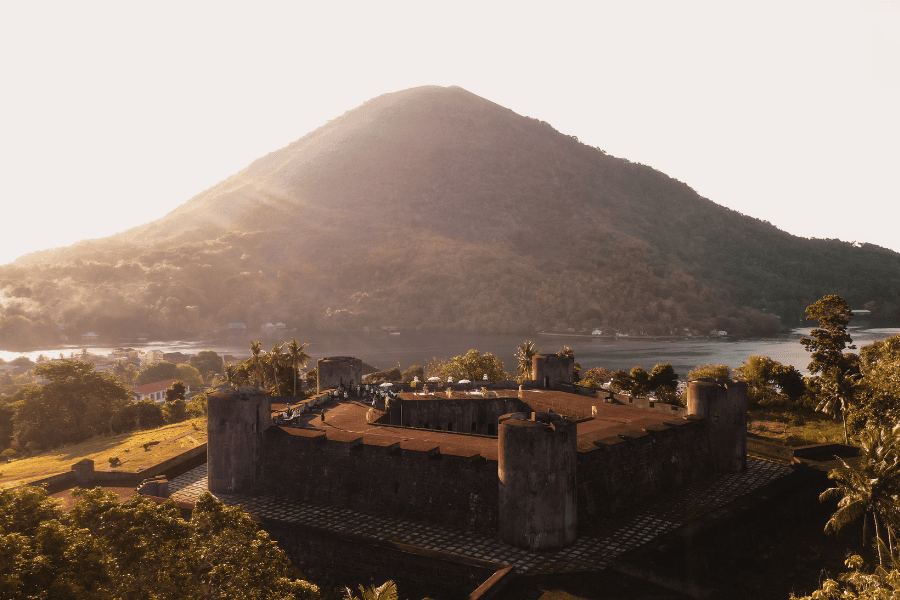
How did the Spice Islands Get their Name?
The story of the Spice Islands is one for the ages – a tale of discovery, war, and immeasurable fortune. Also known as the Maluku Islands, this collection of islands in East Indonesia was once the world’s only source of nutmeg, mace, and cloves – hence its now popularized name. A lot has changed since then but this rich heritage continues to shine through the islands’ rich landscapes and architecture.
While sailing the Spice Islands on Aqua Blu, you’ll have the opportunity to discover the best of the region – from snorkeling and diving off sandy beaches with crystalline waters to exploring legendary relics such as the Dutch-build Fort Belgica.
Discovering the Spice Islands
The tale of the Spice Islands begins even before the 16th century, which was when European traders first discovered the islands and their valuable spice crops. By the time of the Europeans’ arrival, Banda Neira had already been a thriving trading post for centuries.
The islands’ famed spices had actually made their way to Byzantium by the sixth century following which the Arabs had traded the islands’ nutmeg throughout the Middle Ages. By the time it arrived in Venice, it was a highly prized seasoning for the lavish tables of European aristocrats.
Nutmeg was incredibly expensive, with a pound of it costing the equivalent of USD 14,000 today. During the Black Death, the spice was sold at exorbitant prices as people believed it could ward off the deadly plague. There may have been some truth to this as scientists have since discovered that fleas – carriers of the plague – seem to dislike the smell of nutmeg.
The Spice Islands’ claim to fame were their towering Myristica trees, which produce both nutmeg and mace, two of the world’s most aromatic spices. These spices were highly prized commodities, used for flavoring food, as medicine, and even as currency – they were traded for the finest silk, jade, and even gold.
The discovery of the Spice Islands by Portuguese explorer Francesco Serrano in 1512 marked the beginning of a new era for Banda Neira. Over the next two centuries, European powers like the Dutch, Spanish, and English sailed there, vying for a share of the spice rush. The islands became the center of a fierce competition for control and the spices were so highly sought after that at one point, nutmeg was worth more than its weight in gold.
The Spice Wars
Banda Neira’s natural harbor and flat land made it the ideal trading hub within the Spice Islands. After years of battle, it was the Dutch East India Company (VOC) that won control of this hub and by extension, the rest of the Spice Islands.
Unsurprisingly, they established a monopoly on the production and distribution of spices in the region, allowing them to control prices and amass huge profits. The VOC’s monopoly continued to be challenged by other European powers, leading to brutal conflicts that came to be known as the Spice Wars.
This tale of greed, conquest, and bloodshed lasted until French missionary-turned-entrepreneur Pierre Poivre smuggled 3000 nutmeg plants to Mauritius in the mid-18th century, effectively ending the Dutch monopoly.
Exploring the Spice Islands Today

Today, the Spice Islands are a popular tourist destination for those who want to be immersed in history and culture. Aboard Aqua Blu, visitors can explore the islands’ rich history, visit traditional spice farms, and sample the local cuisine. Banda Neira is one of the more popular destinations. It’s a small island that was once the center of the nutmeg trade. This is where you can also visit Fort Belgica, a 17th-century Dutch fort.
Beyond that, the oldest nutmeg plantations in the world are found on Banda Neira too, as are traditional Bandanese traditions such as the kora kora war canoe racing, which has been kept alive by descendants of surviving natives to this day.

The Spice Islands also offer more beyond a cultural immersion — it’s home to some of the most beautiful diving spots in the world. Snorkelers and divers alike can see colorful coral reefs and vast marine biodiversity. Those who prefer to lounge around by the shore can do so on amazing white sandy beaches, sundowners in hand.
The Spice Islands remain a testament to the human desire for exotic and valuable goods. Whether you’re traveling for history, culture, diving opportunities, or just enjoying the natural beauty of the islands, a trip to the Spice Islands is sure to be an unforgettable experience.
Excited to experience the Spice Islands for yourself? Talk to our expedition consultants to find out how you can sail the same waters as Ferdinand Magellan and Francesco Serrano.



